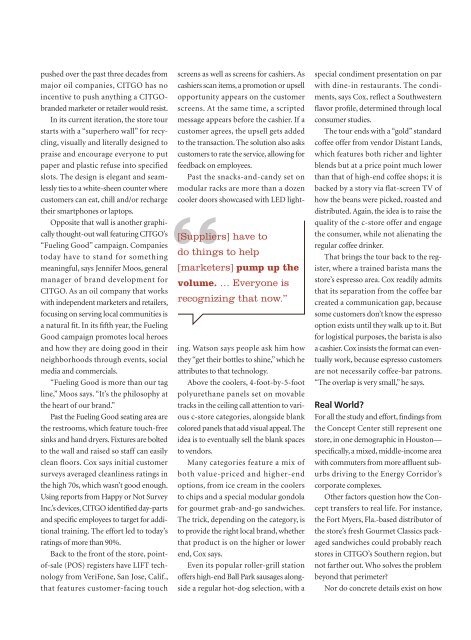You also want an ePaper? Increase the reach of your titles
YUMPU automatically turns print PDFs into web optimized ePapers that Google loves.
pushed over the past three decades frommajor oil companies, <strong>CITGO</strong> has noincentive to push anything a <strong>CITGO</strong>brandedmarketer or retailer would resist.In its current iteration, the store tourstarts with a “superhero wall” for recycling,visually and literally designed topraise and encourage everyone to putpaper and plastic refuse into specifiedslots. The design is elegant and seamlesslyties to a white-sheen counter wherecustomers can eat, chill and/or rechargetheir smartphones or laptops.Opposite that wall is another graphicallythought-out wall featuring <strong>CITGO</strong>’s“Fueling Good” campaign. Companiestoday have to stand for somethingmeaningful, says Jennifer Moos, generalmanager of brand development for<strong>CITGO</strong>. As an oil company that workswith independent marketers and retailers,focusing on serving local communities isa natural fit. In its fifth year, the FuelingGood campaign promotes local heroesand how they are doing good in theirneighborhoods through events, socialmedia and commercials.“Fueling Good is more than our tagline,” Moos says. “It’s the philosophy atthe heart of our brand.”Past the Fueling Good seating area arethe restrooms, which feature touch-freesinks and hand dryers. Fixtures are boltedto the wall and raised so staff can easilyclean floors. Cox says initial customersurveys averaged cleanliness ratings inthe high 70s, which wasn’t good enough.Using reports from Happy or Not SurveyInc.’s devices, <strong>CITGO</strong> identified day-partsand specific employees to target for additionaltraining. The effort led to today’sratings of more than 90%.Back to the front of the store, pointof-sale(POS) registers have LIFT technologyfrom VeriFone, San Jose, Calif.,that features customer-facing touch[Suppliers] have todo things to help[marketers] pump up thevolume. … Everyone isrecognizing that now.”screens as well as screens for cashiers. Ascashiers scan items, a promotion or upsellopportunity appears on the customerscreens. At the same time, a scriptedmessage appears before the cashier. If acustomer agrees, the upsell gets addedto the transaction. The solution also askscustomers to rate the service, allowing forfeedback on employees.Past the snacks-and-candy set onmodular racks are more than a dozencooler doors showcased with LED lighting.Watson says people ask him howthey “get their bottles to shine,” which heattributes to that technology.Above the coolers, 4-foot-by-5-footpolyurethane panels set on movabletracks in the ceiling call attention to variousc-store categories, alongside blankcolored panels that add visual appeal. Theidea is to eventually sell the blank spacesto vendors.Many categories feature a mix ofboth value-priced and higher-endoptions, from ice cream in the coolersto chips and a special modular gondolafor gourmet grab-and-go sandwiches.The trick, depending on the category, isto provide the right local brand, whetherthat product is on the higher or lowerend, Cox says.Even its popular roller-grill stationoffers high-end Ball Park sausages alongsidea regular hot-dog selection, with aspecial condiment presentation on parwith dine-in restaurants. The condiments,says Cox, reflect a Southwesternflavor profile, determined through localconsumer studies.The tour ends with a “gold” standardcoffee offer from vendor Distant Lands,which features both richer and lighterblends but at a price point much lowerthan that of high-end coffee shops; it isbacked by a story via flat-screen TV ofhow the beans were picked, roasted anddistributed. Again, the idea is to raise thequality of the c-store offer and engagethe consumer, while not alienating theregular coffee drinker.That brings the tour back to the register,where a trained barista mans thestore’s espresso area. Cox readily admitsthat its separation from the coffee barcreated a communication gap, becausesome customers don’t know the espressooption exists until they walk up to it. Butfor logistical purposes, the barista is alsoa cashier. Cox insists the format can eventuallywork, because espresso customersare not necessarily coffee-bar patrons.“The overlap is very small,” he says.Real World?For all the study and effort, findings fromthe Concept Center still represent onestore, in one demographic in Houston—specifically, a mixed, middle-income areawith commuters from more affluent suburbsdriving to the Energy Corridor’scorporate complexes.Other factors question how the Concepttransfers to real life. For instance,the Fort <strong>My</strong>ers, Fla.-based distributor ofthe store’s fresh Gourmet Classics packagedsandwiches could probably reachstores in <strong>CITGO</strong>’s Southern region, butnot farther out. Who solves the problembeyond that perimeter?Nor do concrete details exist on how


